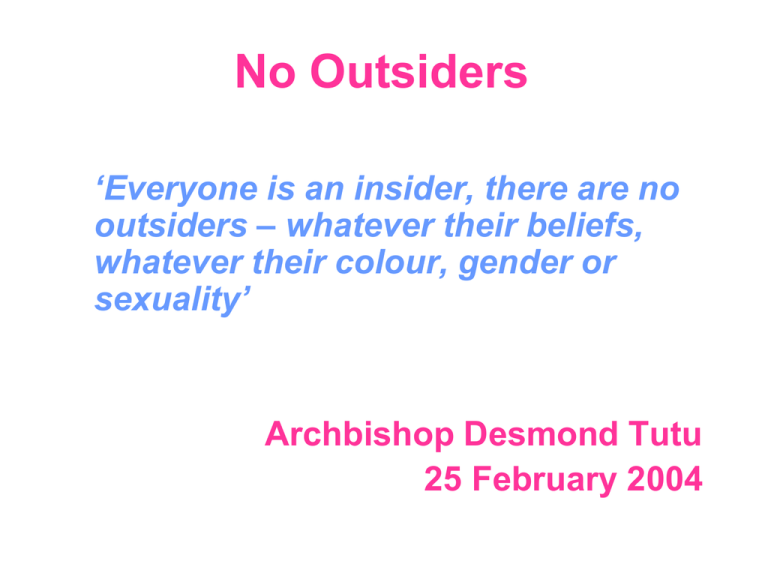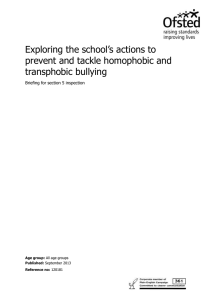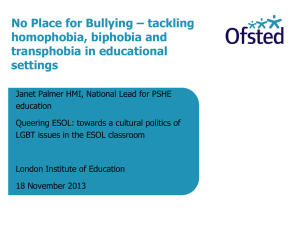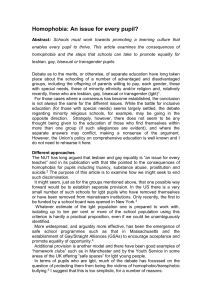
No Outsiders
‘Everyone is an insider, there are no
outsiders – whatever their beliefs,
whatever their colour, gender or
sexuality’
Archbishop Desmond Tutu
25 February 2004
Why talk to children about
LGBT people?
Children from families with
LGBT members often find
no reflection of their family
life in most primary
classrooms
“People will be like oh, how
come you’ve got two
mummies, you can only
have one, and then I have
to explain it all, but other
people don’t really have to
do that.”
Briony, 6
• Children with gay parents don’t like the way
the word ‘gay’ is used as an insult in primary
and secondary school. Some children said
they try and stop people using the word in
this way, but find it difficult
• Children say that teachers think the word
‘gay’ is a bit like a swear word and they
don’t respond to anti-gay language in the
same way they respond to racist language
Stonewall – Different Families (2010)
Why talk to children about
LGBT people?
Children who will grow
up to be LGBT receive
no positive messages
about their own
emerging identities.
• LGB young people
are 4 times more
likely to attempt
suicide
C. 30% of secondary
students could not be
friends with a gay
person
Tacade
• Language that discriminates
against pupils with SEN or
those who are, or are perceived
to be, LGB is common.
• Staff are not always aware of
the extent of its use, or they see
it as banter, so did not
challenge it.
Ofsted, 2012
Allport's Scale of
Prejudice and
Discrimination
Extermination
Physical Attack
Discrimination
Avoidance
Antilocution
Extermination - genocide, suicide, murder
Physical Attack - vandalize, or destroy property, violent
attacks on individuals or groups. Physical bullying, graffitti
Discrimination - denying opportunities and services.
Avoidance - others actively avoid people in a minority group.
Ignoring, excluding
Antilocution - jokes, negative stereotypes, verbal abuse.
Commonly seen as harmless by the majority
“Stereotypes stop you doing stuff...”
‘People seem to be very definite in
their ideas of what a “proper” boy
or a “proper” girl should do or be
interested in. It takes very little
deviation from these so called
norms for a person to be singled
out and picked on’
Primary Teacher
Finn Greig
Gendered Intelligence
What does the
law require us
to do?
Education and Inspections Act,
2006
• Head teachers, with the advice and
guidance of governors and the assistance
of school staff, must identify and
implement measures to promote good
behaviour, respect for others, and self
discipline amongst pupils, and to prevent
all forms of bullying. This includes the
prevention of homophobic bullying
Homophobic bullying
• Bullying someone because they
are - or because you think they
are - gay
• Using words like ‘gay’ to bully
someone for any other reason
• Using the word ‘gay’ to describe
something or - someone - you
don’t like
The public sector equality duty ...
requires public authorities to
• Eliminate discrimination, harassment
and victimisation
• Advance equality of opportunity
• Foster good relations between people
who share a protected characteristic
and people who do not share it
Protected characteristics for the
schools provisions
•
•
•
•
•
•
•
Disability
Gender reassignment
Pregnancy and maternity
Race
Religion or belief
Sex
Sexual orientation
Sexual Orientation
• ...the attraction a person feels towards
one sex or another (or both), which
determines who they form intimate
relationships with or are attracted to
• Some people are only attracted to those
of the same sex
• Some people are attracted to people of
both sexes
• Some people are only attracted to the
opposite sex
Gender reassignment
• … a personal process (rather than a medical
process) which involves a person
expressing their gender in a way that differs
from or is inconsistent with the physical sex
they were born with.
• This personal process may include
undergoing medical procedures or, as is
more likely for school pupils, it may simply
include choosing to dress in a different way
as part of the personal process of change.
Preventing and tackling bullying, DfE 2013
• Bullying is often motivated by prejudice against
particular groups, for example on grounds of
race, religion, gender, sexual orientation or
because a child is adopted or has caring
responsibilities. It might be motivated by actual
differences between children, or perceived
differences.
• Successful schools openly discuss differences
between people that could motivate bullying,
such as religion, ethnicity, disability, gender or
sexuality.
Ofsted School Inspection Handbook, 2013
Inspectors should consider
• types, rates and patterns of bullying and
the effectiveness of the school’s actions to
prevent and tackle all forms of bullying
and harassment – this includes …
prejudice-based bullying related to special
educational need, sexual orientation, sex,
race, religion and belief, gender
reassignment or disability
Ofsted School Inspection Handbook, 2013
Inspectors should consider
• the effectiveness of the school’s actions to
prevent and tackle discriminatory and
derogatory language – this includes
homophobic and racist language, and
language that is derogatory about disabled
people
Ofsted School Inspection Handbook, 2013
Evidence of pupils’ spiritual, moral, social
and cultural development can be found,
for example, where pupils
• develop awareness of and respect for
diversity in relation to, for example,
gender, race, religion and belief, culture,
sexual orientation and disability
With primary pupils inspectors might explore
whether
• pupils ever hear anyone use the word ‘gay’
when describing something, or whether they
have been told by teachers that using the word
‘gay’, to mean something is rubbish, is wrong,
scary or unpleasant and why it is wrong
• pupils ever get picked on by other children for
not behaving like a ‘typical girl’ or a ‘typical boy’
Exploring the school’s actions to prevent and tackle homophobic and
transphobic bullying, Ofsted 2014
With primary pupils inspectors might explore
whether
• pupils have had any lessons about different
types of families (single parent, living with
grandparents, having step-parents, having two
mums or two dads)
• pupils think if there is someone born a girl who
would rather be a boy, or born a boy who would
like to be a girl, they would feel safe at school
and be included.
Exploring the school’s actions to prevent and tackle homophobic and
transphobic bullying, Ofsted 2014
They might also explore
• how instances of homophobic or
transphobic language in school are
recorded and acted upon
• whether the school’s bullying and
safeguarding policies address gender
identity and sexuality
Exploring the school’s actions to prevent and tackle homophobic and
transphobic bullying, Ofsted 2014
They might also explore
• whether the school has taken any action to
ensure that provision meets the needs of
LGBT pupils, for example in SRE and other
aspects of PSHE, including providing ageappropriate advice and guidance
• how the school seeks to support LGBT
pupils and those from LGBT families
Exploring the school’s actions to prevent and tackle homophobic and
transphobic bullying, Ofsted 2014
Employment equality (sexual orientation)
regulations 2003
This legislation bans discrimination on the grounds of
actual or perceived sexual orientation. It bans direct
and indirect discrimination and harassment
Staff who believe they have been discriminated
against can submit a complaint to an employment
tribunal
An employer who fails to take steps to challenge a
culture of homophobia (where, for example,
homophobic remarks regularly go unchallenged)
could find itself challenged by an employee even if
that employee has not been in receipt of direct
homophobic abuse
• “Children can’t chose
who works with
them. They’re
entitled to be
accepted - whatever
we think.”
All staff need to be able to
• challenge homophobia, transphobia and
gender stereotypes
• explain why such behaviour is
unacceptable
• answer young people’s questions about
sexuality and gender honestly and
• talk about the subject of sexual
orientation and gender identity without
embarrassment.
© Mark Jennett 2014
mark.jennett@btinternet.com
07779 193711
http://projects.sunderland.ac.uk/archived/ell-nooutsiders/












